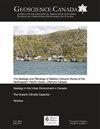不列颠哥伦比亚省东北部阿莱碳酸盐岩杂岩的地层学和U-Pb锆石-钛矿地质年代学:加拿大科迪勒拉前陆带Antler年龄造山的证据
IF 0.8
4区 地球科学
Q3 GEOSCIENCES, MULTIDISCIPLINARY
引用次数: 4
摘要
加拿大科迪勒拉山脉中部前陆带碳酸盐岩侵入体的构造意义和时代受到了很差的限制。最近的工作表明,其中一个碳酸盐岩侵入体,阿莱碳酸盐岩,是作为同运动岩床侵位的,与一个主要的推覆构造事件同时发生。因此,确定阿莱碳酸岩的年龄提供了一种直接测定同构造岩浆作用年代的方法。由于取样锆石中的U–Pb含量较低,对碳酸盐岩单元进行年代测定的尝试失败了;然而,从Ospika管中获得了365.9±2.1 Ma的U–Pb钛酸盐年龄,Ospika管道是一种在空间和遗传学上与碳酸盐岩相关的超镁铁质岩。管道和空间相关煌斑岩脉的40Ar/39Ar金云母年龄分别为359.4±3.4 Ma和353.3±3.6 Ma,进一步支持了这种U–Pb钛酸岩年龄。我们将Ospikapipe的晚泥盆纪U–Pb钛酸岩年龄解释为碳酸盐岩和同岩浆推覆体形成构造事件的最小可能年龄。碳酸盐岩的最大可能年龄受Road河群早泥盆世年龄的限制,Road河群是碳酸盐岩脉侵入的最年轻地层,参与了推覆体形成事件。我们对阿莱碳酸岩的测年结果与加拿大南部科迪勒拉中部前陆带Ice River碳酸岩杂岩获得的U–Pb锆石和钙钛矿年龄密切相关,并支持将西部前陆带的碳酸岩侵入体解释为碱性碳酸岩岩浆区的成因联系组分。阿莱地区的结构、地层和地质年代数据表明,变形在风格上与安特勒造山运动的结构相似,并与之同时代,并且与将科迪勒兰边缘的长度从美国南部延伸到阿拉斯加的安特勒运动相一致。本文章由计算机程序翻译,如有差异,请以英文原文为准。
Stratigraphy and U–Pb Zircon–Titanite Geochronology of the Aley Carbonatite Complex, Northeastern British Columbia: Evidence for Antler-Aged Orogenesis in the Foreland Belt of the Canadian Cordillera
The tectonic significance and age of carbonatite intrusions in the central Foreland Belt of the Canadian Cordillera are poorly constrained. Recent work has demonstrated that one of these carbonatite intrusions, the Aley carbonatite, was emplaced as a syn-kinematic sill, coeval with a major nappe-forming tectonic event. Determining the age of the Aley carbonatite thus provides a means of directly dating syn-tectonic magmatism. Attempts at dating carbonatite units failed due to low U–Pb content in sampled zircon; however, a U–Pb titanite age of 365.9 ± 2.1 Ma was obtained from the Ospika pipe, an ultramafic diatreme spatially and genetically related to the carbonatite. This U–Pb titanite age is further supported by respective 40Ar/39Ar phlogopite ages of 359.4 ± 3.4 Ma and 353.3 ± 3.6 Ma for the pipe and a spatially associated lamprophyre dyke. We interpret the Late Devonian U–Pb titanite age of the Ospikapipe to be the minimum possible age of the carbonatite and syn-magmatic nappe-forming tectonic event. The maximum possible age of the carbonatite is constrained by the Early Devonian age of the Road River Group, the youngest strata intruded by carbonatite dykes and involved in the nappe-forming event. Our dating results for the Aley carbonatite closely correlate with U–Pb zircon and perovskite ages obtained for the Ice River carbonatite complex in the central Foreland Belt of the southern Canadian Cordillera, and support the interpretation of carbonatite intrusions of the western Foreland Belt as genetically linked components of an alkaline-carbonatitic magmatic province. Structural, stratigraphic, and geochronological data from the Aley area indicate that deformation was similar in style to, and coeval with, structures attributable to the Antler orogeny, and are consistent with the Antler orogen having extended the length of the Cordilleran margin from the southern United States to Alaska.
求助全文
通过发布文献求助,成功后即可免费获取论文全文。
去求助
来源期刊

Geoscience Canada
地学-地球科学综合
CiteScore
3.30
自引率
0.00%
发文量
9
审稿时长
>12 weeks
期刊介绍:
Established in 1974, Geoscience Canada is the main technical publication of the Geological Association of Canada (GAC). We are a quarterly journal that emphasizes diversity of material, and also the presentation of informative technical articles that can be understood not only by specialist research workers, but by non-specialists in other branches of the Earth Sciences. We aim to be a journal that you want to read, and which will leave you better informed, rather than more confused.
 求助内容:
求助内容: 应助结果提醒方式:
应助结果提醒方式:


